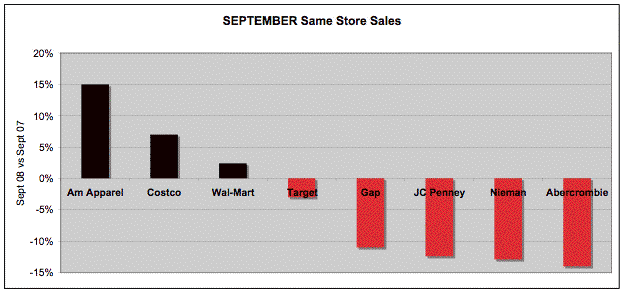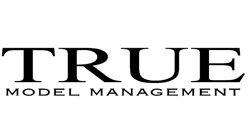Retail: A Short Guide to Survival
Retail: A Short Guide to Survival
by David Birnbaum
At this moment the retail garment industry is something like a drowning man who is saved only to be hanged. The hanging may have killed him, but he was going down for the third time in any case.
As you can see from the chart below, September sales look pretty awful, and that was before the October traumas.

Given the seeming disintegration of the world economies, it is pretty easy for retailers to claim they are victims of circumstances beyond their control. However, as comforting as this may be to management, their problems existed long before the current financial crisis.
The problems facing garment retailers are neither recent nor are they unique. They have been a generation in coming and are endemic to almost all industries. In a nutshell: We have been taught to keep our eyes focused on the bottom line and in doing in so have completely ignored the top line. Contrary to what we have been taught, we are not in business to make money. We are in business to supply our customers with goods and services. Provided these goods and services give value — as measured by our customers — we make money. Industry is all about delivery — delivery before profit.
Crisis in the 21st Century Garment Industry |
When the Boeing Company delayed design on a new commercial airplane because it was cost-effective to sell the older model for yet another year; or when Ford and General Motors continued to push SUVs and delayed designing more fuel-efficient cars; their collective eyes were on the bottom line, not the top line. Their management forgot why they were in business in the first place. The good news is that Boeing management recognized their mistake in time to recover. The jury is still out on GM and Ford.
Nowhere is this myopic vision more apparent than in the U.S. garment retail business, where both style and quality have been sacrificed in the pursuit of money. We are supposedly in the fashion business, but in reality we have moved from the fashion business to the profit business. The result is that we produce neither style, quality; nor profit.
So here we sit in this remarkably awkward position, where simultaneously we have achieved both the highest gross margins and the lowest profits in our history.
Retailers now look for a 75% mark-up — four times their cost. When they fail to make a minimum of 58%, they charge back the difference to their suppliers. At the same time, retailers will take new merchandise, often their best-selling styles, and mark them down as parts of “door-busting” sales — and still charge back their wholesale suppliers for the lost markup. Clearly this is an industry that has forgotten why they are in business.
This strategy would make some sense if it were working, but after having failed for so many years, one would think that management was ready for a change.
I am sure everyone sees the problem: If the goods were not selling before, when the economy was doing well, what should we do now that the economy has gone south?
There are three possible strategic changes.
1. The most common strategy appears to be more of the same: Higher margins and more sales. The underlying logic is that even though the consumer was not buying our stuff before, they will start to buy when we provide them with less value at higher prices.
2. The more intelligent strategy appears to be less of the same: Same margins but smaller quantities. This is the Gap strategy. The underlying logic is that markdowns are the result of too much goods chasing too few customers. Therefore, the goal is to reduce the quantity of goods in inventory to the point where you have a customer for every garment. This might have worked, had the economy not turned so bad, so quickly. However, in the current environment, of double-digit sales declines coupled with a forty-eight week delivery cycle, you simply cannot reduce order quantities sufficiently nor move quickly enough to get ahead of the curve. To put it simply, in today’s world, inventory will not equal customers until both are at zero — not a good place to be.
3. The workable strategy — and the one yet to be tried — is none of the same: Even in the worst of times, consumers still buy clothing just less of it. What should I do to ensure the clothing they buy is the clothing I sell? The answer is to give the consumer more value for their money than the next retailer. Give them better style, better quality, faster turns, and lower margins. Value always sells well. In bad times value is the only thing that sells.
The real question is, why thus far has no U.S. retailer tried the none-of-the-same strategy? Let’s face it, as everyone reading this article knows, strategies 1 and 2 are pathetic. Ours is an industry with many intelligent, educated, and hardworking people. Why do we stay with nonsense? Are we all in the grip of some subconscious compulsion to go broke?
The easy answer is that we have convinced ourselves that our customer — the U.S. consumer — is a moron. We have no need to provide value. We are sure that somehow we will be able to sell him something he does not want, when what he does want is available from Wal-Mart or American Apparel or Zara or H&M.
This is the MofU theory. This is the way that young investment-banker machers and hedge-fund mavens used to refer to themselves — Masters of the Universe, hence MofU. They were the smartest people in the world. They had it all figured out, right up to the instant their universe imploded and those For Sale signs started to hatch all over the Hamptons. Needless to say, we, in our industry, have our own garmento version of MofU. Sometimes we import them from other industries, as if we have a shortage of the homegrown variety.
As appealing is the MofU theory, I do not buy it. I think we are smarter than that. I also believe that we garmentos have a lower capacity for self-delusion than our friends operating in the soon-to-be-extinct investment banking industry. I believe that most of us are aware that our current strategies suck, and as much as we would like to live in denial, we know that unless we create and implement new strategies geared for the 21st century, our companies - like the investment - banks, will soon disappear.
So why do we persist? Why are we acting like a bunch of drowning, soon-to-be-hanged victims?
The answer is fear. All of our experience, all of our training, and all of our ability seem to be locked into a bunch of failed strategies. We know that if we stay with these strategies we will drown but we fear if we leap into something new, something beyond our experience, training and most frightening beyond our ability, we will wind up hanged.
I have spent a lifetime creating and implementing change. I know that change is not only hard, it is fundamentally unfair. To change is to reject the very things that seemingly give us value as professionals. It is as if somebody comes up to you and says, “Your experience, your knowledge, all useless.”
The good news is that we have no choice. To quote an old Zulu expression:
If we go forward we die
If we go backward we die
Therefore let us go forward and die.
From The Birnbaum Report/Strategic Sourcing for Garment Importers.







































